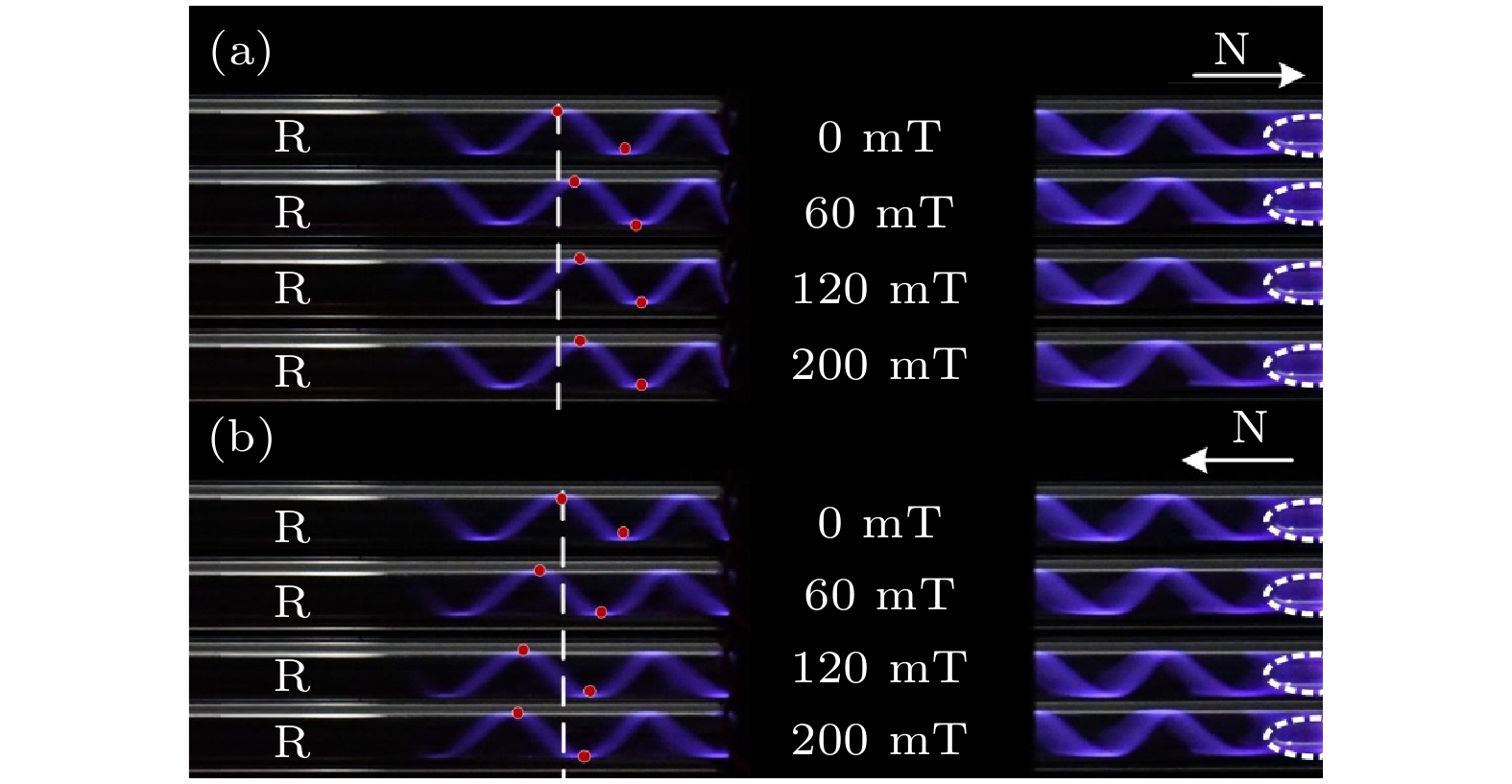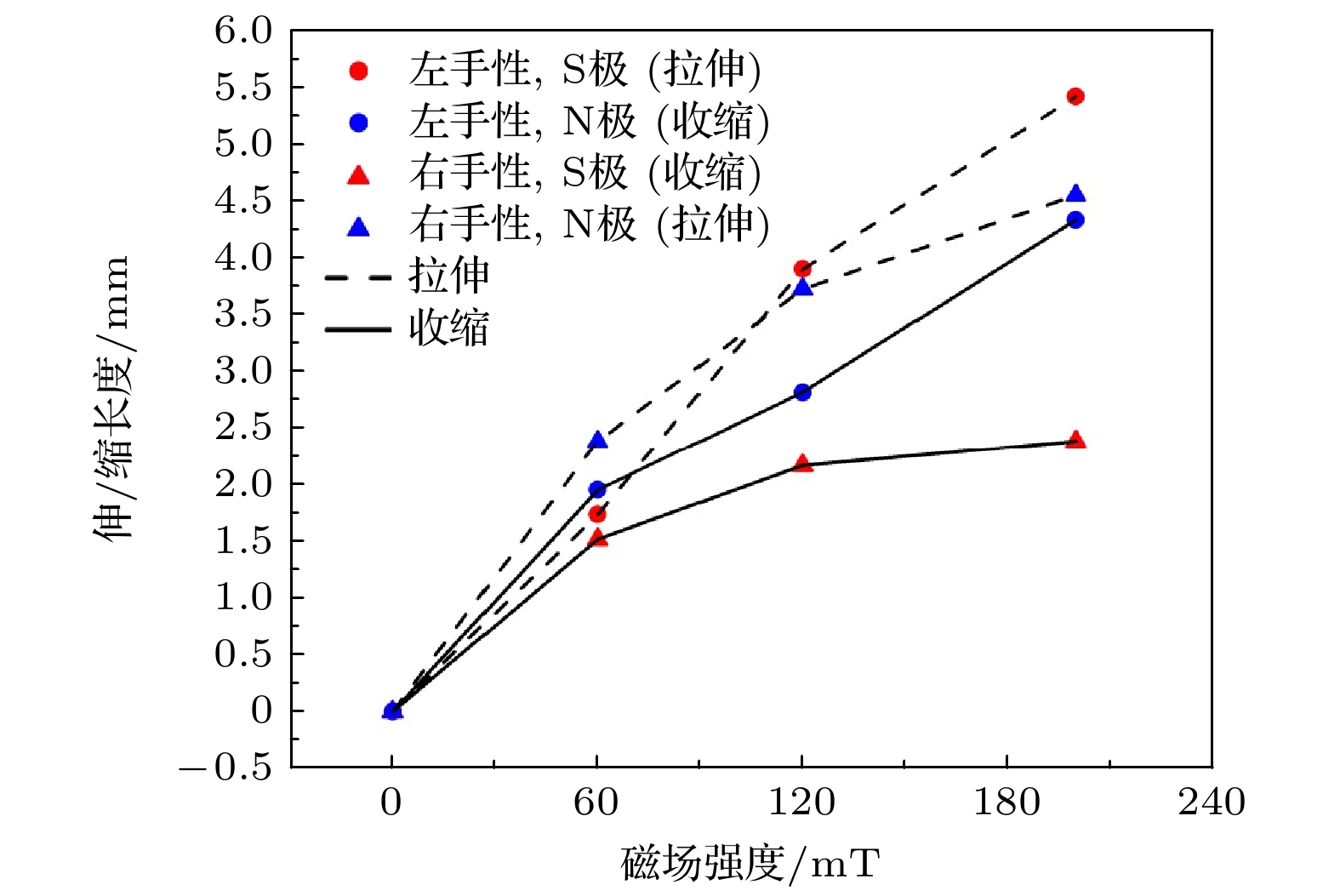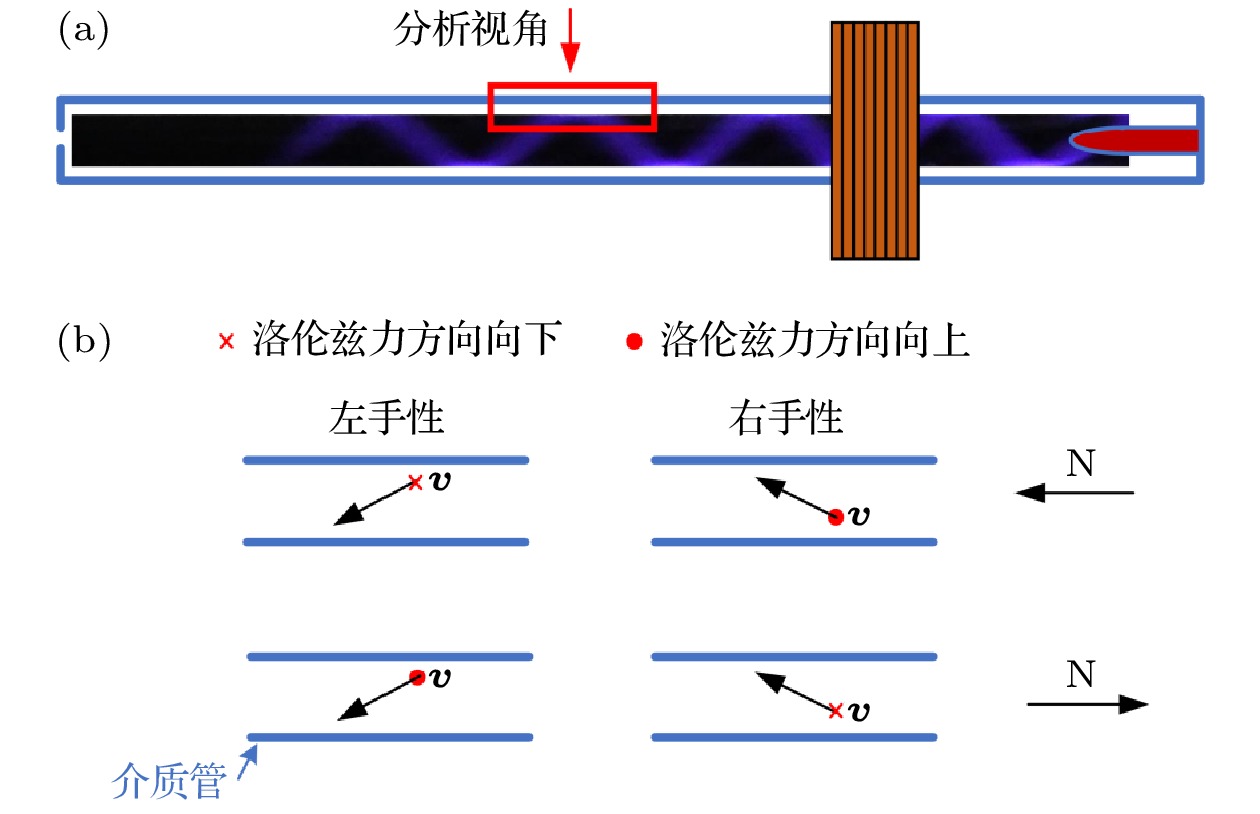-
在低气压、氮气环境及无外加磁场的情况下发现了一种新型等离子体, 因其具有规则的螺旋传播模式, 被称为螺旋等离子体. 尽管已经对该螺旋等离子体的关键特性进行了大量研究, 螺旋等离子体的形成机理仍未理清, 这影响其在材料、纳米技术上的应用. 通过在不同手性的螺旋等离子体外施加磁场, 研究外加磁场对螺旋等离子体的调控行为, 发现外加磁场将会使得螺旋等离子体发生收缩、拉伸等行为. 并且, 外加磁场还会影响螺旋等离子体的手性和螺旋形态的清晰度. 通过电磁波理论计算螺旋等离子体的径向电场, 理清外加磁场影响螺旋等离子体行为的机理, 发现洛伦兹力的磁场力分量是外加磁场调控螺旋等离子体行为的原因. 本文为理解螺旋等离子体的运动行为打下理论基础, 有利于将来在材料、纳米技术等领域的实际应用.
Electric phenomena and magnetic phenomena are inseparable. The magnetic field affects the ionization balance and spatial distribution of the plasma. A new type of plasma discharges has been found in nitrogen gas under sub atmospheric pressure condition without external magnetic field. Because of its regular helical propagation pattern, it is called helical plasma (HP) plume. Although a great deal of research has been carried out on the key characteristics of the HP plume, the formation mechanism of it remains unclear, which affects its applications in materials and nanotechnology. By applying magnetic field to HP with different chirality, the regulation behavior of the external magnetic field on HP is studied. It is found that the external magnetic field will make the HP shrink or stretch. With the magnetic field intensity increasing from 0 mT to 200 mT, the left-handed HP plume stretches under the magnetic field of S-pole. Conversely, the left-handed chiral HP plume contracts when the magnetic pole changes to N-pole. However, when the chirality of HP plume is changed to being right-handed by adjusting voltage, phenomenon opposite to the previous one is observed. Moreover, the applied magnetic field also affects the divergence of HP. With the increase of S-pole external magnetic field, the HP plume stretches until the external magnetic field reaches to 80 mT. When the magnetic field intensity is 80 mT, the HP disappears. The plasma in the quartz tube appears in the divergent form. With the magnetic field intensity increasing to 160 mT, the plasma in the form of a helix appears again. Finally, in the process of changing the intensity of the magnetic field, the clarity of the HP plume will also change. The radial electric field of HP is calculated by electromagnetic wave theory, and the mechanism of the influence of external magnetic field on the behavior of HP is clarified. It is found that the magnetic field force component of Lorentz force is responsible for the external magnetic field regulating the HP behavior. This study lays a theoretical foundation for understanding the motion behavior of HP, which is conducive to the practical applications in the field of materials and nanotechnology. -
Keywords:
- atmosphere pressure plasma /
- plasma jet /
- nonequilibrium plasma /
- electrohydrodynamic
[1] Cheng H, Luo J, Song K, Zhao F, Liu D, Nie L, Lu X 2022 Phys. Plasmas 29 063506
 Google Scholar
Google Scholar
[2] Luo J, Nie L, Liu D, Lu X 2022 Plasma Processes Polym. 19 e2200181
 Google Scholar
Google Scholar
[3] Guo D, Yu D, Zhang P, Song W, Zhang B, Peng K 2021 Surf. Coat. Tech. 415 127129
 Google Scholar
Google Scholar
[4] Baniya H B, Guragain R P, Subedi D P 2021 Progress in Adhesion and Adhesives (Hoboken: Wiley Scrivener Publishing LLC) p841
[5] Meyyappan M 2011 J. Phys. D: Appl. Phy. 44 174002
 Google Scholar
Google Scholar
[6] Morabit Y, Hasan M I, Whalley R D, Robert E, Modic M, Walsh J L 2021 Eur. Phys. J. D 75 1
 Google Scholar
Google Scholar
[7] Lin L, Keidar M 2021 Appl. Phys. Rev. 8 011306
 Google Scholar
Google Scholar
[8] Adhikari B C, Lamichhane P, Lim J S, Nguyen L N, Choi E H 2021 Results Phys. 30 104863
 Google Scholar
Google Scholar
[9] Chen Z, Obenchain R, Wirz R E 2021 Processes 9 249
 Google Scholar
Google Scholar
[10] Douat C, Escot Bocanegra P, Dozias S, Robert É, Motterlini R 2021 Plasma Processes Polym. 18 2100069
 Google Scholar
Google Scholar
[11] Liu C, Hung C W, Cheng I C, Hsu C C, Cheng I C, Chen J Z 2021 Polymers 13 3585
 Google Scholar
Google Scholar
[12] Park J Y, Kim G H, Kim J D, Koh H S, Lee D C 1998 Combust. Sci. Technol. 133 65
 Google Scholar
Google Scholar
[13] Ferreira J L, Monteiro K M F P, Damasio H J, Kostov K G 1998 Combust. Sci. Technol. 140 1
 Google Scholar
Google Scholar
[14] Moon J D, Lee G T, Chung S H 1999 IEEE T. Ind. Appl. 35 1198
 Google Scholar
Google Scholar
[15] Pekárek S 2010 Eur. Phys. J. D 56 91
 Google Scholar
Google Scholar
[16] Sternberg N, Godyak V, Hoffman D 2006 Phys. Plasmas 13 063511
 Google Scholar
Google Scholar
[17] Kharzeev D E, Yee H U 2011 Phys. Rev. D 83 1451
 Google Scholar
Google Scholar
[18] Zou D, Cao X, Lu X, Ostrikov K 2015 Phys. Plasmas 22 103517
 Google Scholar
Google Scholar
[19] Nie L, Liu F, Zhou X, Lu X, Xian Y 2018 Phys. Plasmas 25 053507
 Google Scholar
Google Scholar
[20] Liu F, Li J, Wu F, Nie L, Lu X 2018 J. Phys. D: Appl. Phys. 51 294003
 Google Scholar
Google Scholar
[21] Li L, Liang W, Yang L, Cao F, Sun K, Ban C, Cui J 2022 Int. J. Metalcast. 17 399
 Google Scholar
Google Scholar
-
图 2 施加电压为3.5 kV时, 左手性HP在不同极性和磁场强度下的照片 (a) S极磁场下左手性HP出现拉伸现象; (b) N极磁场下左手性HP出现收缩现象
Fig. 2. Photographs of the left-handedness chiral HP plume at different polarity and intensity of the magnetic field at the applied voltage is 3.5 kV: (a) Contraction photographs of the left-handedness chiral HP plume at S-pole; (b) stretching photographs of the left-handedness chiral HP plume at N-pole.
图 3 施加电压为3.8 kV时, 右手性HP在不同极性和磁场强度下的照片 (a) S极磁场下右手性HP出现收缩现象; (b) N极磁场下右手性HP出现拉伸现象
Fig. 3. Photographs of the right-handedness chiral HP plume at different polarity and intensity of the magnetic field at the applied voltage is 3.8 kV: (a) Contraction photographs of the right-handedness chiral HP plume at S-pole; (b) stretching photographs of the right-handedness chiral HP plume at N-pole.
表 1 外加磁场对HP拉伸和收缩影响的实验结果
Table 1. Effect of external magnetic field on the stretch and contraction of HP.
等离子体手性 S极 N极 左手性 拉伸 收缩 右手性 收缩 拉伸 -
[1] Cheng H, Luo J, Song K, Zhao F, Liu D, Nie L, Lu X 2022 Phys. Plasmas 29 063506
 Google Scholar
Google Scholar
[2] Luo J, Nie L, Liu D, Lu X 2022 Plasma Processes Polym. 19 e2200181
 Google Scholar
Google Scholar
[3] Guo D, Yu D, Zhang P, Song W, Zhang B, Peng K 2021 Surf. Coat. Tech. 415 127129
 Google Scholar
Google Scholar
[4] Baniya H B, Guragain R P, Subedi D P 2021 Progress in Adhesion and Adhesives (Hoboken: Wiley Scrivener Publishing LLC) p841
[5] Meyyappan M 2011 J. Phys. D: Appl. Phy. 44 174002
 Google Scholar
Google Scholar
[6] Morabit Y, Hasan M I, Whalley R D, Robert E, Modic M, Walsh J L 2021 Eur. Phys. J. D 75 1
 Google Scholar
Google Scholar
[7] Lin L, Keidar M 2021 Appl. Phys. Rev. 8 011306
 Google Scholar
Google Scholar
[8] Adhikari B C, Lamichhane P, Lim J S, Nguyen L N, Choi E H 2021 Results Phys. 30 104863
 Google Scholar
Google Scholar
[9] Chen Z, Obenchain R, Wirz R E 2021 Processes 9 249
 Google Scholar
Google Scholar
[10] Douat C, Escot Bocanegra P, Dozias S, Robert É, Motterlini R 2021 Plasma Processes Polym. 18 2100069
 Google Scholar
Google Scholar
[11] Liu C, Hung C W, Cheng I C, Hsu C C, Cheng I C, Chen J Z 2021 Polymers 13 3585
 Google Scholar
Google Scholar
[12] Park J Y, Kim G H, Kim J D, Koh H S, Lee D C 1998 Combust. Sci. Technol. 133 65
 Google Scholar
Google Scholar
[13] Ferreira J L, Monteiro K M F P, Damasio H J, Kostov K G 1998 Combust. Sci. Technol. 140 1
 Google Scholar
Google Scholar
[14] Moon J D, Lee G T, Chung S H 1999 IEEE T. Ind. Appl. 35 1198
 Google Scholar
Google Scholar
[15] Pekárek S 2010 Eur. Phys. J. D 56 91
 Google Scholar
Google Scholar
[16] Sternberg N, Godyak V, Hoffman D 2006 Phys. Plasmas 13 063511
 Google Scholar
Google Scholar
[17] Kharzeev D E, Yee H U 2011 Phys. Rev. D 83 1451
 Google Scholar
Google Scholar
[18] Zou D, Cao X, Lu X, Ostrikov K 2015 Phys. Plasmas 22 103517
 Google Scholar
Google Scholar
[19] Nie L, Liu F, Zhou X, Lu X, Xian Y 2018 Phys. Plasmas 25 053507
 Google Scholar
Google Scholar
[20] Liu F, Li J, Wu F, Nie L, Lu X 2018 J. Phys. D: Appl. Phys. 51 294003
 Google Scholar
Google Scholar
[21] Li L, Liang W, Yang L, Cao F, Sun K, Ban C, Cui J 2022 Int. J. Metalcast. 17 399
 Google Scholar
Google Scholar
计量
- 文章访问数: 5611
- PDF下载量: 122
- 被引次数: 0














 下载:
下载:






